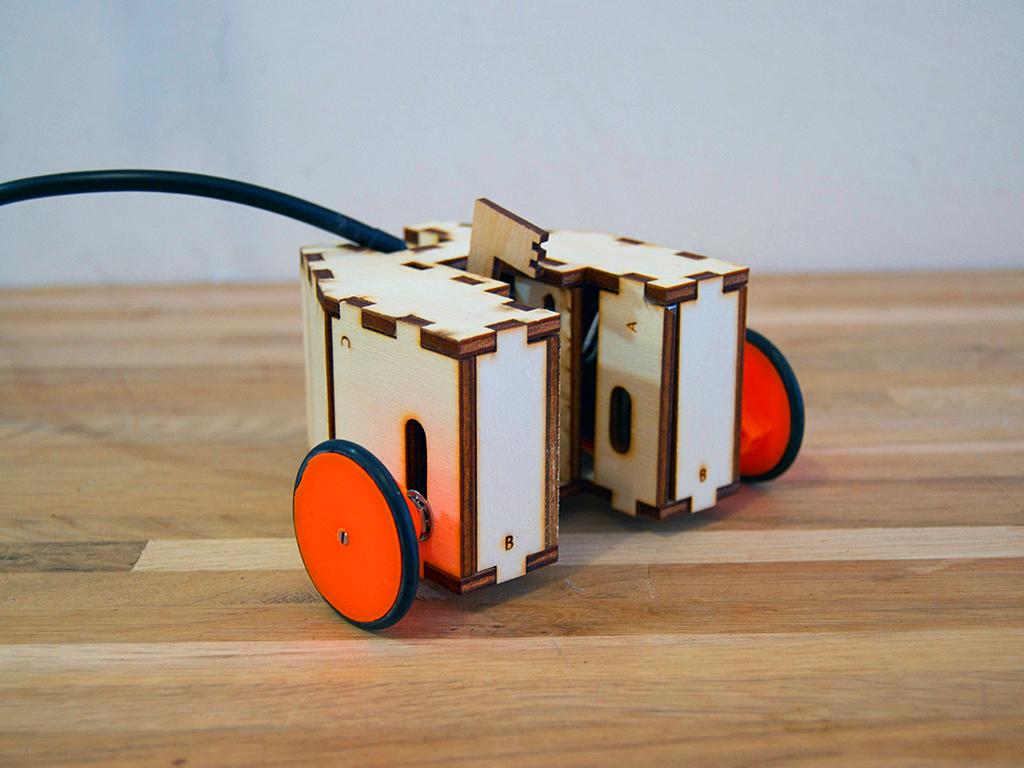This year's Fab Academy has come to an end. On June 4th, students of the Waag's Fab Academy (as well as several other students from Europe guided by us) presented their final projects to a global audience through a live video conference. Because their work is the cumulation of six months of intensive learning and craftsmanship, these students were undoubtedly excited to share their creations with their fellow Fab Academy students across the world.
The video conference itself included 86 students from around the world, which meant that keeping track of who was speaking over which feed was somewhat difficult from time to time. On top of this confusion, some of the participants' microphones and audio connections were poor, which occasionally made hearing the presentations challenging. Despite these issues, the setup worked extremely well, and technical difficulties were minimal. As a result, we were able to see demonstrations of everything from a 3D printed hummingbird feeder to an interactive desk companion (shaped like a cactus!) to a robotic sculpture mimicking the movements of the human face.
Of course, being able to watch the live presentations in the auditorium at the Waag was also impressive. Emma Pareschi (one of the students from Fablab Amsterdam) demonstrated a beautifully crafted wooden, puzzle toy that lights up an LED and plays a short song when fully assembled. Jean-Baptiste Heren (from the Etoele Eurl Fab Lab in France) presented his custom controller for a 'Capture the flag' game he created in Processing. His controller was made using 3D printed wheels and laser-cut plywood forms, the overall effect of which was very pleasing to the eye. Additionally, Martin Risseeuw (another student from Amsterdam) demonstrated his 'Happiness Lamp', a project which seeks to elicit happiness in users through the practice of reflection. The lamp's design was a simple and elegant combination of acrylic and milled ash wood that hid the interior electronics. All of these presentations went very well (with only one minor hiccup) and received praise from Prof. Neil Gershenfeld, the director of the course.
Not only did I get to witness these students' fantastic presentations, but I also had the opportunity to interview Jean-Baptiste Heren and Emma Pareschi about their experiences with the program:
What is your background?
Jean-Baptiste: "I am 36 years old and married with two children. I have a master's degree in computing, software and company management. These last 12 years, I have been working as a linux system administrator, Java developer, and as a consultant."
Emma: "I have a physics degree with an electronics specialization and 6 years of working experience as an analog design engineer for a semiconductor company (which means that I designed microchips)."
How did you find out about the Fab Academy and what made you want to participate?
Jean-Baptiste: "I discovered the Fab Academy when my friends and I planned to start a hacker space in my city of Amiens, France. I think this was a post from the French Fab Lab Toulouse in 2011. I was totally impressed by the contents, the Fablab network and the way it is done: distributed classes. What a chance and challenge it would be!"
Emma: "When I moved to Amsterdam for personal reasons, I had time to develop my personal projects. So, through Google, I found out about the Fablab and the open days. Frequenting the Fablab, I discovered the Academy. It was my chance to fully enjoy and use the potentiality of the Fablab. My knowledge was only relegated to electronics and now, after the Academy, I can develop all that is necessary to get a prototype."
Why did you choose this particular project?
Jean-Baptiste: "I wanted to make one device and one application that work together. This is certainly related to my developer background. Of course, I see it as a first step and an experiment I am happy to share with anyone. I plan to add features to it — like wireless and drawing capabilities. Reducing the components cost is also part of the list."
Emma: "I wanted to develop a toy for kids, and I guess I was also affected by Amsterdam. I really like the care that the city shows for them: activities, places, events. There are so many kids everywhere. I wanted to develop something that every child could use, and I thought to implement different kind of interactions, like sounds and lights especially for the special needs children."
What do you plan to do now that you've completed the Fab Academy?
Jean-Baptiste: "I will continue to work at making our Fab Lab Etoele survive and expand. We are working hard at finding a business model that could guarantee our independence and allow us to open more. And, of course, we are happy to share our experience."
Emma: "For the near future, I'm going to leave on the 7th of June for Dhahran, Saudi Arabia to join a two-week prototyping workshop that takes place in the local Fablab where I will give my contribution as a Mentor specialized in electronics. When I come back, I only know that I don't want to leave my Woo-jungle in a drawer. I see in it good potential and I will try to make it grow."
Because there were students from various walks of life all at varying stages of their work, the final Fab Academy video conference was a diverse and fascinating event to behold. Some projects were prototypes still in the process of being finished, while others were fully fleshed out products that appeared ready for commercial production. Overall, my impression of the program was positive — even inspiring. One particularly ambitious participant was only twelve years old! Such enthusiastic participation from such a varied group bodes well for the future of the program. Hopefully, these recent graduates will use their newfound skills to spread their knowledge to future students.


